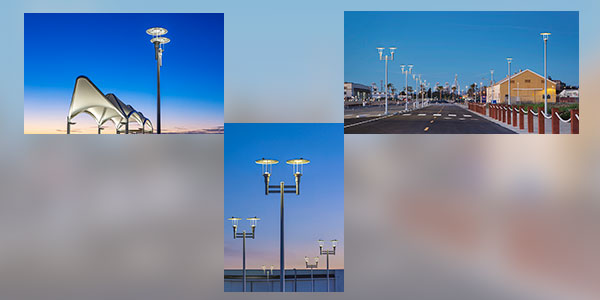Located on an island within the San Francisco Bay, Naval Air Station Alameda was decommissioned in 1997 and since that time had remained relatively untouched. The site is now being transformed by the city, and the new Alameda Point development is home to the Seaplane Lagoon Ferry Terminal, public parks, and housing.
Beyond its history as a naval station, this part of the island was also the U.S. base for Pan Am’s China Clipper. The flying boat transported mail and passengers from San Francisco to Asia and Australia in the 1930s and 1940s. In a salute to its illustrious past and to reflect the existing art deco style architecture found at the former base, elements of that aesthetic are woven into the ferry terminal and surrounding buildings’ design.
Architectural lighting design firm HLB Lighting Design was hired to create the lighting scheme for Alameda Point, including the ferry terminal, adjacent parking, public pathways, parks, and streetscapes. The design team sought a new lighting standard for the area for several reasons.
“Alameda’s existing street lighting standard was a traditional ‘acorn’ style,” said Andrew Moore, senior associate at HLB Lighting Design and lead designer for Alameda Point. “The design team didn’t feel that style luminaire would harmonize with the character of the architecture that was to be built on-site and would have appeared jarring in that context.”
Equally important, the acorn fixture did not provide full cut-off, which would have had environmental ramifications. The region is home to several birds and wildlife species, including a colony of endangered California Least Terns that nest on the former airfield. Therefore, an Environmental Impact Report determined that no uplight would be permitted.
HLB selected Luminis’ Eclipse EC801 luminaire, which is mounted on Luminis’ PTA round tapered aluminum pole. The fixture and pole will become the new standard for the City of Alameda for future phases of the Alameda Point build-out.
There are approximately 30 fixtures at Seaplane Lagoon and its immediate vicinity. Double-headed luminaires line the waterfront promenade, illuminating bike paths, pedestrian pathways, and a parking area adjacent to the dock. Six single head fixtures are installed on the floating dock to facilitate safe transit for ferry passengers, regardless of the hour.
Eclipse EC801 brings with it a multitude of high-performance options to specifically support the project. An advanced optical system offers full cut-off, ensuring there is no uplight negatively impacting local wildlife. The choice of 3000K color temperature was also an environmental consideration. Research has shown that this particular color temperature is less harmful to humans’ and wildlife’s natural circadian rhythms.
Moore chose a Type III distribution for all fixtures at Alameda Point, because the EC801 also lines roadways and adjacent walkways and sidewalks. As a result, it illuminates the full width of the streetscape.
“I really appreciate the visual comfort of this luminaire,” said Moore. “Its low glare performance was very appealing to us when specifying the product. This quality along with the uniform illumination it provides serves to establish a sense of well-being for all users of the project’s public realm.”
Luminis collaborated with HLB to provide some additional modifications to the luminaires to anticipate the city’s future needs. Light levels are adjustable via a step dimming switch, giving public works the versatility to make local adjustments as required. As well, the luminaire has been adapted for the future provision of a 7-pin photocell, which the city can add at a later date if and when it moves towards a smart city system.
“I’ve had the opportunity to visit the site several times, both day and night,” Moore said. “The Eclipse luminaires and accompanying poles are a very attractive complement to adjacent buildings. The quality of the illumination they provide is comfortable and inviting, and the streetscapes feel safe and secure.”
Project Name: Seaplane Lagoon Ferry Terminal; Alameda, California Lighting Designer: HLB Lighting. Photography: Billy Hustace









